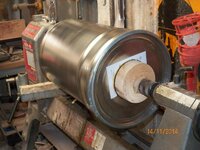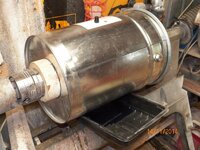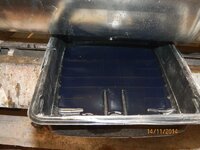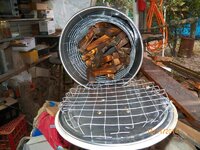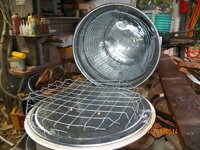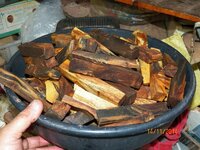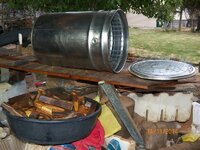robutacion
Member
Hi peoples
This is an issue that would have any interest, in my view, to those stabilizing a fair amount of blanks, particularly the very soft woods that do absorb a lot of Juice and that, regardless of how much time you leave them draining, they still retain a lot more juice than they require and subsequently, create a big mess when curing them in the oven.
Wrapping the blanks if foil, may keep the excess juice inside but, any small hole in the foil and juice gets in places that should in that oven, particularly in the hot elements, creating a lot a smoke, hardening is hard places to reach/clean and creating a tremendous risk of fire, believe me, Cactus juice when ignites, it burns hot and fast, I had my first oven fire, a couple of weeks ago, only put down with one of the 4 x 1kg powder fire extinguishers I have set near the working areas.
The reason of the fire (Cactus Juice ignition), was caused but 3 crucial elements, firstly the issue of putting in the oven blanks that are too saturated with the juice but no longer drains any excess, the fact that, I was doing double dying while stabilizing and I need to set the first colour before I would stabilize again with then second colour.
The wood was the #70 Coral tree wood but, I have far too many woods that will suck Cactus Juice as this wood does...! I need to prevent the excess juice to harden in the blanks outside surfaces as that would have to be sanded down and completely block/clog the wood cell to allow any soaking on the second colour so, I stacked the blanks in the oven, with a small gap in between them and use 5mm square strips of wood as separators on the layers stacked above ( 5 layers in total). I made sure I had the drip tray clean and in its place (just above the bottom heating element)...!
So far so good so, the idea was to allow the excess Juice to drip off the wood and into the tray underneath, the excess juice from the top layers would simply run over the blanks underneath that therefore would drip again and fall into the tray, eventually...!
Looking at all this, you won't see any problems, right...??? Sure, neither did I, I had done this many times before without any problems HOWEVER, and that is what caused the fire, I wanted to give the blanks/juice a quick heat, close to the 90°Celsius it requires to cure but, instead of leaving them there for 90 minutes, I only wanted to create a "partial" setting of the juice, just enough to not blend with the second dye colour...!
So far so good, you would think so, what caused the fire...??? Well, here is where I made a big mistake, I decided to turn the thermostat knob to the max. to heat the oven inside a lot quicker and then turn it down to the 90 degrees, I had one of the blanks with the first colour that had been cured as I wanted to turn it into one of my round samples, and finished with CA to see it the blank with the one colour would look good enough...!
I trusted my mind to alert me that the oven was turned to max. heat, 5 minutes or so later but, when I started working on the sample, I totally forgot about the oven. I was only about 3 meters from the oven but, I couldn't see it from where I was so, some time later, 10 minutes maybe, I started smelling something burning, and looking towards the direction where the oven was, I could see lots of smoke, was then when I realize what I just did and stepping towards it to turn it off, I saw that flames were coming through the top gap of the glass door.
I knew better than open the door and allow more oxygen to feed the flames so, I turned around and within 1 meter, I reached for the closest fire extinguisher, open the oven door and gave it a good squirt, aimed at the oven's base as I can see the origin of the flames. It went out but re-ignited 2 more times before it was out, completely. I then reach for the button to switch if off, if it had went any further, it would activate the safety switch I have in the shed, before it would go to the main power meter box...!
At this point, you would ask, what has all this to do with the thread title..???
Well, I could have went straight to the reason I made this "jig" and, ignore the fire fact however, I though that, it could be important to make you folks aware that, Cactus Juice does ignite, in certain circumstances, these were my circumstances because, I had too much juice in the wood...!
I have actually talked to Curtis about this idea to remove the excess resin from the wood to save on the product, using the normal stabilizing jobs/woods with great capability to soak far more that what is needed...!
The test I done then, was using a small container with half a dozen blanks in it and I was surprised with the amount of juice that come out of them, after the blanks were draining for almost 24 hours.
My main goal was to save Cactus Juice, the cost of importing each gallon from the USA to Australia, is considerable and I use a lot of this product so, I needed to be able to save some, where it could be saved, without compromising any of the results.
A couple of days ago, I cut some "Fig" wood from a small fig tree I had removed about 1 year ago, the main trunk and some of the larger limbs were taken to my wood storage paddock, and the rest I took home, some processed it straight away, the rest was put under cover in one of the sheds.
The fig wood that I had under the roof, endup in the firewood pile, the little wood borer bugs, totally ruin it, was useless so, when I went to the paddock a few days ago, I saw that the fig wood I had there, was not contaminated from the borers but, it had cracked pretty bad with lots of spalting in the process so, I decided to bring it home and process it.
Most of the blanks cut, were only any good for casting however, they were just amazingly beautiful but a little soft so, I decided to stabilize them. There are nearly a couple of hundred blanks to stabilize so, I though that was time for me to put the washing machine drum spinning idea, into practice...!
I needed something fairly large, the vacuum chamber has a capacity of about 80 pen blanks, and so does the oven so, I need to make something where I could fit a full load from the vacuum chamber. Looking around the only thing that it seems to be suitable, was a resin empty 20lt drum so, a few modifications and I was ready to test it for the first time.
I did, and at a speed about 500rpm, the drum spin and spin for about 15 minutes, after that I stopped it with the "bung/plug" down and let the excess resin drain out, about 1/4 of a litre was saved from one full vacuum chamber stabilizing session, that is 1/4 of a litre that I would have to scrape or sand out of the blanks or, let it run into the oven drip tray and see it being turned into a solid useless material that had to be scraped out from the tray, never an easy job...!
OK, it may look and even be a bit "primitive" but, this is what I had to work with, I can do better, with better materials, would it work any better, I doubt...!:wink::biggrin:
I had the blanks that come out of the spinning cycle, cooked in the oven. without ant foil paper but only, with the wooden sticks as spacers, 90 minutes later, I was there (evening) to get them out and see if was any resin on the tray, not a single drop however, some blanks got stuck to the wooden sticks but, they all come out fairly easy with the aid of a knife blade so, this lot is ready to be cast, with 2 more lots to follow, today and tomorrow...!
I hope you learnt something from it, any questions...??? just shoot...!:wink:
Cheers
George
This is an issue that would have any interest, in my view, to those stabilizing a fair amount of blanks, particularly the very soft woods that do absorb a lot of Juice and that, regardless of how much time you leave them draining, they still retain a lot more juice than they require and subsequently, create a big mess when curing them in the oven.
Wrapping the blanks if foil, may keep the excess juice inside but, any small hole in the foil and juice gets in places that should in that oven, particularly in the hot elements, creating a lot a smoke, hardening is hard places to reach/clean and creating a tremendous risk of fire, believe me, Cactus juice when ignites, it burns hot and fast, I had my first oven fire, a couple of weeks ago, only put down with one of the 4 x 1kg powder fire extinguishers I have set near the working areas.
The reason of the fire (Cactus Juice ignition), was caused but 3 crucial elements, firstly the issue of putting in the oven blanks that are too saturated with the juice but no longer drains any excess, the fact that, I was doing double dying while stabilizing and I need to set the first colour before I would stabilize again with then second colour.
The wood was the #70 Coral tree wood but, I have far too many woods that will suck Cactus Juice as this wood does...! I need to prevent the excess juice to harden in the blanks outside surfaces as that would have to be sanded down and completely block/clog the wood cell to allow any soaking on the second colour so, I stacked the blanks in the oven, with a small gap in between them and use 5mm square strips of wood as separators on the layers stacked above ( 5 layers in total). I made sure I had the drip tray clean and in its place (just above the bottom heating element)...!
So far so good so, the idea was to allow the excess Juice to drip off the wood and into the tray underneath, the excess juice from the top layers would simply run over the blanks underneath that therefore would drip again and fall into the tray, eventually...!
Looking at all this, you won't see any problems, right...??? Sure, neither did I, I had done this many times before without any problems HOWEVER, and that is what caused the fire, I wanted to give the blanks/juice a quick heat, close to the 90°Celsius it requires to cure but, instead of leaving them there for 90 minutes, I only wanted to create a "partial" setting of the juice, just enough to not blend with the second dye colour...!
So far so good, you would think so, what caused the fire...??? Well, here is where I made a big mistake, I decided to turn the thermostat knob to the max. to heat the oven inside a lot quicker and then turn it down to the 90 degrees, I had one of the blanks with the first colour that had been cured as I wanted to turn it into one of my round samples, and finished with CA to see it the blank with the one colour would look good enough...!
I trusted my mind to alert me that the oven was turned to max. heat, 5 minutes or so later but, when I started working on the sample, I totally forgot about the oven. I was only about 3 meters from the oven but, I couldn't see it from where I was so, some time later, 10 minutes maybe, I started smelling something burning, and looking towards the direction where the oven was, I could see lots of smoke, was then when I realize what I just did and stepping towards it to turn it off, I saw that flames were coming through the top gap of the glass door.
I knew better than open the door and allow more oxygen to feed the flames so, I turned around and within 1 meter, I reached for the closest fire extinguisher, open the oven door and gave it a good squirt, aimed at the oven's base as I can see the origin of the flames. It went out but re-ignited 2 more times before it was out, completely. I then reach for the button to switch if off, if it had went any further, it would activate the safety switch I have in the shed, before it would go to the main power meter box...!
At this point, you would ask, what has all this to do with the thread title..???
Well, I could have went straight to the reason I made this "jig" and, ignore the fire fact however, I though that, it could be important to make you folks aware that, Cactus Juice does ignite, in certain circumstances, these were my circumstances because, I had too much juice in the wood...!
I have actually talked to Curtis about this idea to remove the excess resin from the wood to save on the product, using the normal stabilizing jobs/woods with great capability to soak far more that what is needed...!
The test I done then, was using a small container with half a dozen blanks in it and I was surprised with the amount of juice that come out of them, after the blanks were draining for almost 24 hours.
My main goal was to save Cactus Juice, the cost of importing each gallon from the USA to Australia, is considerable and I use a lot of this product so, I needed to be able to save some, where it could be saved, without compromising any of the results.
A couple of days ago, I cut some "Fig" wood from a small fig tree I had removed about 1 year ago, the main trunk and some of the larger limbs were taken to my wood storage paddock, and the rest I took home, some processed it straight away, the rest was put under cover in one of the sheds.
The fig wood that I had under the roof, endup in the firewood pile, the little wood borer bugs, totally ruin it, was useless so, when I went to the paddock a few days ago, I saw that the fig wood I had there, was not contaminated from the borers but, it had cracked pretty bad with lots of spalting in the process so, I decided to bring it home and process it.
Most of the blanks cut, were only any good for casting however, they were just amazingly beautiful but a little soft so, I decided to stabilize them. There are nearly a couple of hundred blanks to stabilize so, I though that was time for me to put the washing machine drum spinning idea, into practice...!
I needed something fairly large, the vacuum chamber has a capacity of about 80 pen blanks, and so does the oven so, I need to make something where I could fit a full load from the vacuum chamber. Looking around the only thing that it seems to be suitable, was a resin empty 20lt drum so, a few modifications and I was ready to test it for the first time.
I did, and at a speed about 500rpm, the drum spin and spin for about 15 minutes, after that I stopped it with the "bung/plug" down and let the excess resin drain out, about 1/4 of a litre was saved from one full vacuum chamber stabilizing session, that is 1/4 of a litre that I would have to scrape or sand out of the blanks or, let it run into the oven drip tray and see it being turned into a solid useless material that had to be scraped out from the tray, never an easy job...!
OK, it may look and even be a bit "primitive" but, this is what I had to work with, I can do better, with better materials, would it work any better, I doubt...!:wink::biggrin:
I had the blanks that come out of the spinning cycle, cooked in the oven. without ant foil paper but only, with the wooden sticks as spacers, 90 minutes later, I was there (evening) to get them out and see if was any resin on the tray, not a single drop however, some blanks got stuck to the wooden sticks but, they all come out fairly easy with the aid of a knife blade so, this lot is ready to be cast, with 2 more lots to follow, today and tomorrow...!
I hope you learnt something from it, any questions...??? just shoot...!:wink:
Cheers
George

